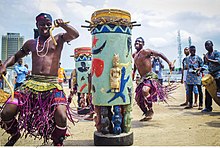| Revision as of 19:37, 7 January 2025 editMoriwen (talk | contribs)Extended confirmed users, New page reviewers27,291 edits added Category:Drums using HotCat← Previous edit | Revision as of 19:38, 7 January 2025 edit undoMoriwen (talk | contribs)Extended confirmed users, New page reviewers27,291 edits added Category:Nigerian musical instruments using HotCatNext edit → | ||
| Line 9: | Line 9: | ||
| ] | ] | ||
| ] | |||
Revision as of 19:38, 7 January 2025

Satọ drum is a single-faced drum among the Ogu people of West Africa. The drum is very popular among the Ogu of Badagry in Lagos State. Sato is a tall twin drum with a height of 7 feet or more. In traditional Ogu culture, the drum is believed to ward off evil spirits. In contemporary times, Sato drum performance is a common feature in many traditional festivals and cultural celebrations in Nigeria. The Sato is acclaimed to be the largest and tallest drum in the world.
Tradition

In Ogu tradition, the Sato is believed to be a revered twin drum, comprising male and female single-faced drums made from the Iroko tree and an animal-skin membrane. The Sato drum is played at major festivals and ceremonies. Each of the two drums is commonly beaten by a four-member group of drummers, who dance energetically around the tall drums. The drummers are usually dressed in a special attire, and they chant esoteric songs. Sato drum performances consist of an ensemble in which the main Sato drummers are supported by a troupe of other drummers and percussionists playing other smaller drums and brass instruments.
References
- Magazine, Tour Africa (2018-06-09). "The Sato Drummer". TourAfricaMag.com. Retrieved 2025-01-07.
- Emelike, Obinna (2024-07-07). "Kamal Atiku: Badagry artist, who spotlights Egun heritage through his works". Businessday NG. Retrieved 2025-01-07.